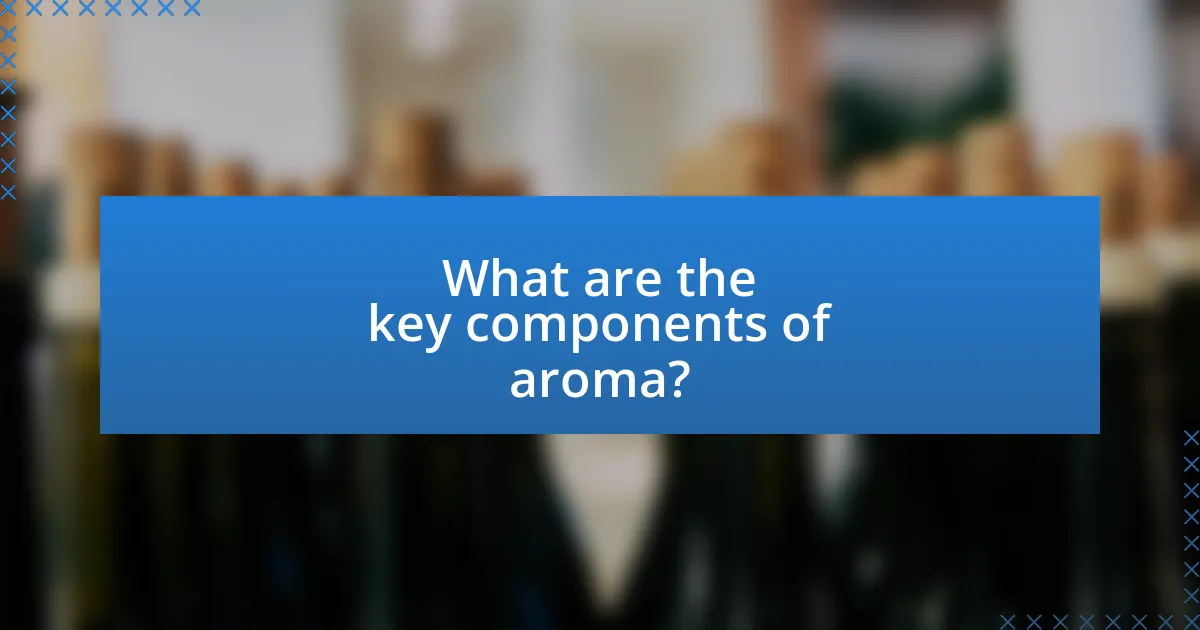The article focuses on the science behind aroma and its significant role in enhancing the tasting experience. It explains how the olfactory system detects volatile compounds, contributing to flavor perception, with approximately 80% of taste derived from smell. Key components of aroma, including various volatile compounds and their interactions with taste, are discussed, along with the biological mechanisms of aroma perception. The article also explores how environmental factors, serving methods, and cooking techniques can influence aroma, ultimately enhancing the overall enjoyment of food and beverages. Practical tips for improving aroma appreciation and common mistakes to avoid are also provided, emphasizing the importance of mindful tasting.

What is the Science Behind Aroma?
The science behind aroma involves the detection of volatile compounds by the olfactory system, which plays a crucial role in flavor perception. When substances release aromatic molecules, these compounds travel through the air and bind to olfactory receptors in the nasal cavity. This binding triggers signals to the brain, particularly the olfactory bulb, which processes and interprets these signals as distinct smells. Research indicates that humans can detect over one trillion different scents, highlighting the complexity and sensitivity of the olfactory system. Additionally, studies show that aroma significantly influences taste, with approximately 80% of flavor perception attributed to smell, as demonstrated in research published in the journal “Chemical Senses” by authors such as Thomas Hummel and others.
How does aroma influence our tasting experience?
Aroma significantly influences our tasting experience by enhancing flavor perception and contributing to the overall enjoyment of food and beverages. The human sense of smell is closely linked to taste; approximately 80% of what we perceive as flavor comes from aroma. This connection is supported by research indicating that when aroma is diminished, such as during a cold or nasal congestion, the ability to taste is severely impaired. For example, a study published in the journal “Chemical Senses” by researchers at the University of California, Davis, found that participants could identify flavors more accurately when aroma was present, highlighting its critical role in flavor identification and enjoyment.
What are the biological mechanisms of aroma perception?
Aroma perception occurs primarily through the olfactory system, which involves the detection of volatile compounds by olfactory receptors in the nasal cavity. When aromatic molecules enter the nose, they bind to specific olfactory receptors, initiating a signal transduction pathway that sends information to the olfactory bulb in the brain. This process allows the brain to identify and differentiate various smells. Research indicates that humans possess approximately 400 types of olfactory receptors, which can combine to recognize a vast array of odors, contributing to the complexity of aroma perception. Additionally, the limbic system, which is involved in emotion and memory, plays a crucial role in how aromas are processed and experienced, linking scents to emotional responses and memories.
How do different aromas interact with taste?
Different aromas significantly enhance and influence taste perception by activating olfactory receptors that interact with taste buds. This interaction occurs because the human brain integrates signals from both the taste and smell systems, creating a more complex flavor experience. Research indicates that approximately 80% of what we perceive as taste is actually derived from our sense of smell, highlighting the critical role of aromas in flavor perception. For example, studies have shown that the aroma of vanilla can enhance the sweetness of a food, even if the actual sugar content remains unchanged. This demonstrates how aromas can modify the perception of taste, leading to a richer and more enjoyable eating experience.
Why is aroma important in food and beverage?
Aroma is crucial in food and beverage because it significantly influences flavor perception and overall enjoyment. The human sense of smell contributes to approximately 80% of what we perceive as taste, making aroma a key factor in the tasting experience. Research indicates that aroma compounds interact with taste receptors, enhancing flavors and creating a more complex sensory experience. For instance, studies have shown that the aroma of food can evoke memories and emotions, further enriching the dining experience.
What role does aroma play in flavor perception?
Aroma significantly influences flavor perception by contributing to the overall sensory experience of taste. The human brain processes aroma through olfactory receptors, which interact with volatile compounds released from food, enhancing the complexity and richness of flavors. Research indicates that approximately 80% of what we perceive as taste is actually derived from smell, highlighting the critical role aroma plays in distinguishing flavors. For example, studies have shown that when individuals consume food while their sense of smell is blocked, they report a diminished flavor experience, underscoring the interdependence of aroma and taste in flavor perception.
How does aroma affect our overall enjoyment of food?
Aroma significantly enhances our overall enjoyment of food by influencing taste perception and evoking emotional responses. The olfactory system, responsible for detecting aromas, interacts with taste receptors to create a more complex flavor experience; research indicates that up to 80% of what we perceive as taste is actually derived from smell. For instance, a study published in the journal “Chemical Senses” by Small and Prescott (2005) demonstrated that participants rated food as more enjoyable when the aroma was present, highlighting the critical role of scent in flavor perception.

What are the key components of aroma?
The key components of aroma are volatile compounds, which are primarily responsible for the scent of substances. These compounds can be categorized into various classes, including terpenes, esters, aldehydes, and alcohols, each contributing distinct olfactory characteristics. For instance, terpenes are commonly found in essential oils and are known for their strong fragrances, while esters often impart fruity aromas. The interaction of these volatile compounds with olfactory receptors in the nose leads to the perception of aroma, which plays a crucial role in flavor and overall sensory experience. Studies have shown that aroma significantly influences taste perception, with research indicating that up to 80% of what we perceive as taste is actually derived from smell.
What are the primary types of aroma compounds?
The primary types of aroma compounds include terpenes, esters, aldehydes, ketones, and alcohols. Terpenes are responsible for the characteristic scents of many plants and fruits, such as limonene in citrus and pinene in pine. Esters, formed from the reaction of acids and alcohols, contribute fruity aromas, like ethyl acetate in bananas. Aldehydes, such as vanillin, provide distinct flavors and scents, often found in vanilla. Ketones, like diacetyl, impart buttery notes, while alcohols, such as ethanol, can also contribute to aroma profiles. These compounds play a crucial role in the sensory experience of food and beverages, influencing flavor perception and enjoyment.
How do volatile compounds contribute to aroma?
Volatile compounds contribute to aroma by evaporating easily at room temperature, allowing them to be detected by the olfactory receptors in the nose. These compounds, such as esters, aldehydes, and terpenes, are responsible for the distinct scents associated with various foods and beverages. For example, the aroma of ripe strawberries is primarily due to the presence of the volatile compound ethyl butanoate. Studies have shown that the perception of aroma significantly influences flavor perception, with research indicating that up to 80% of taste is derived from smell.
What is the significance of non-volatile compounds in aroma?
Non-volatile compounds play a crucial role in aroma by contributing to the overall sensory experience of food and beverages. These compounds, which do not evaporate easily, interact with volatile compounds to enhance and stabilize the aroma profile. For instance, in wine, non-volatile phenolic compounds can influence the perception of aroma by affecting the release and retention of volatile aromatic compounds during tasting. Research indicates that the balance between volatile and non-volatile compounds is essential for creating complex and appealing aromas, as seen in studies on various food products where non-volatile components significantly impact flavor perception and aroma intensity.
How do environmental factors influence aroma?
Environmental factors significantly influence aroma by affecting the chemical composition of volatile compounds. Temperature, humidity, and air quality can alter the release and perception of these compounds. For instance, higher temperatures can increase the volatility of aromatic compounds, making them more pronounced, while humidity can enhance the solubility of certain compounds in food and beverages, affecting how aromas are perceived. Studies have shown that specific environmental conditions can lead to variations in aroma profiles, impacting sensory experiences during tasting.
What impact does temperature have on aroma release?
Temperature significantly affects aroma release by influencing the volatility of aromatic compounds. Higher temperatures increase the kinetic energy of molecules, leading to a greater release of volatile compounds into the air. For instance, studies have shown that heating food or beverages enhances the perception of their aromas, as seen in the release of volatile compounds in coffee and wine when served warm. This phenomenon is supported by the principle that increased temperature lowers the viscosity of liquids, allowing for easier diffusion of aroma molecules.
How does the serving method affect aroma perception?
The serving method significantly influences aroma perception by altering the way volatile compounds are released and experienced. For instance, serving a beverage in a wide glass allows for greater surface area exposure, facilitating the evaporation of aromatic compounds, which enhances the olfactory experience. Research indicates that the shape and material of the serving vessel can also affect the concentration and dispersion of aromas; a study published in the journal “Food Quality and Preference” found that wine served in different glass shapes resulted in varying aroma intensities perceived by tasters. Thus, the choice of serving method directly impacts the overall sensory experience by modifying how aromas are perceived.

How can we enhance our tasting experience through aroma?
To enhance our tasting experience through aroma, we can focus on the intentional pairing of scents with flavors. Research indicates that aroma significantly influences taste perception, with studies showing that up to 80% of flavor is derived from smell. For instance, when tasting wine, the olfactory receptors detect volatile compounds that contribute to the overall flavor profile, enhancing the experience. By incorporating aromatic elements, such as herbs or spices, into food and drink, we can create a more complex and enjoyable tasting experience.
What techniques can be used to enhance aroma in food and beverages?
Techniques to enhance aroma in food and beverages include the use of aromatic ingredients, proper cooking methods, and the application of specific serving techniques. Aromatic ingredients such as herbs, spices, and citrus zest can significantly elevate the scent profile of dishes and drinks. Cooking methods like roasting, grilling, or sautéing can intensify the release of volatile compounds that contribute to aroma. Additionally, serving techniques such as using warm glassware for beverages or presenting food in a way that allows for better aroma exposure can further enhance the olfactory experience. These methods are supported by culinary science, which emphasizes the importance of aroma in flavor perception, as evidenced by studies showing that aroma accounts for a significant portion of taste experience.
How can pairing aromas with specific foods improve taste?
Pairing aromas with specific foods can significantly enhance taste by activating olfactory receptors that influence flavor perception. When aromas are matched with foods, they create a multisensory experience that can amplify the overall enjoyment of a dish. Research indicates that approximately 80% of what we perceive as taste is actually derived from our sense of smell, highlighting the importance of aroma in flavor enhancement. For example, the aroma of basil can elevate the flavor of tomatoes, making the dish more palatable and enjoyable. This synergy between aroma and food not only enhances the taste but also enriches the eating experience by creating a more complex flavor profile.
What are some methods to intensify aroma during cooking?
To intensify aroma during cooking, one effective method is to use fresh herbs and spices, as they release essential oils that enhance fragrance. When herbs like basil or rosemary are added at the beginning of cooking, their oils infuse the dish, creating a more robust aroma. Additionally, toasting spices such as cumin or coriander in oil before adding other ingredients can significantly amplify their scent, as heat activates their aromatic compounds. Studies show that the Maillard reaction, which occurs when proteins and sugars are heated, also contributes to the development of complex aromas in cooked foods, making techniques like searing or roasting particularly effective for enhancing overall fragrance.
What practical tips can improve aroma appreciation?
To improve aroma appreciation, practice smelling a variety of scents in a controlled environment. Engaging in this activity enhances olfactory sensitivity and memory, allowing for better recognition of different aromas. Research indicates that repeated exposure to diverse fragrances can strengthen neural pathways associated with smell, leading to improved aroma identification and enjoyment. Additionally, using techniques such as smelling from different angles and taking slow, deliberate breaths can further enhance the experience, as these methods allow for a more nuanced perception of complex aromas.
How can mindful tasting enhance aroma recognition?
Mindful tasting enhances aroma recognition by promoting focused attention on sensory experiences. This practice encourages individuals to slow down and engage fully with the aromas present, allowing for a deeper analysis of the complex scent profiles. Research indicates that mindfulness can improve sensory perception; for instance, a study published in the journal “Psychological Science” found that mindfulness training enhances sensory discrimination abilities. By concentrating on each aroma without distraction, individuals can better identify and differentiate between various scents, leading to a more enriched tasting experience.
What are common mistakes to avoid when trying to appreciate aroma?
Common mistakes to avoid when trying to appreciate aroma include not using the correct glassware, failing to aerate the substance, and neglecting to engage multiple senses. Using inappropriate glassware can hinder the release of volatile compounds, which are essential for aroma perception. For instance, a wide bowl allows for better aeration and aroma concentration compared to a narrow glass. Additionally, not aerating the substance, such as wine or food, can prevent the full range of aromas from being experienced, as many aromas develop and become more pronounced when exposed to air. Engaging only the sense of smell without considering taste can also limit the appreciation of aroma, as the two senses are interconnected; research shows that aroma significantly influences flavor perception.


